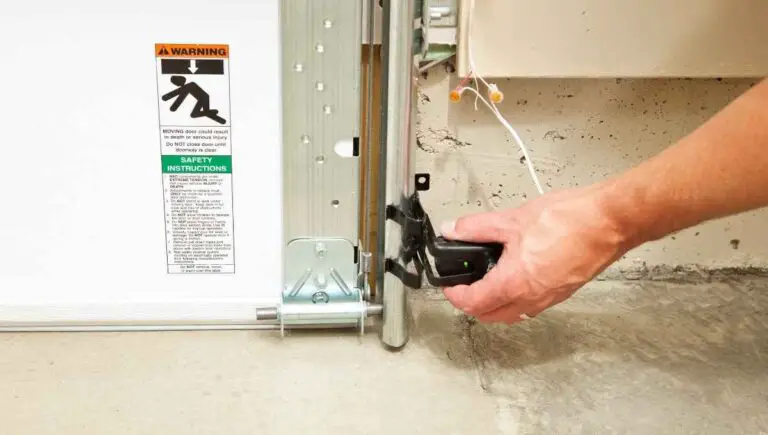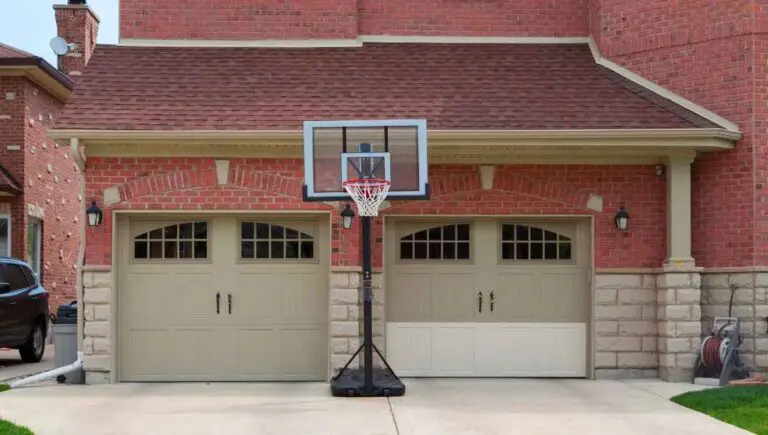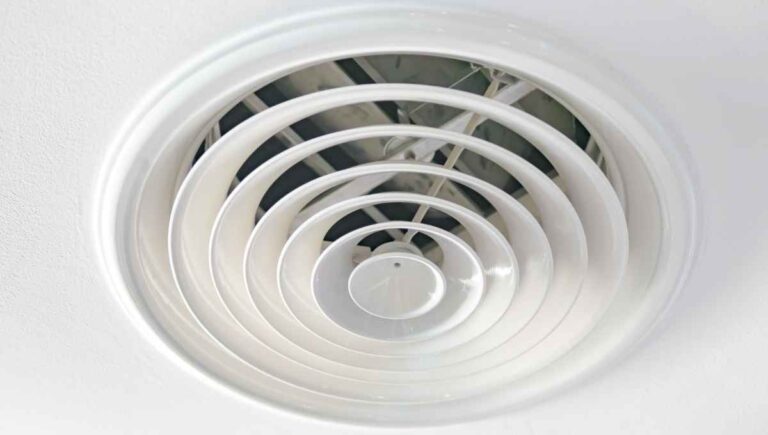Do Floodlights Need Planning Permission? (Floodlight Laws)
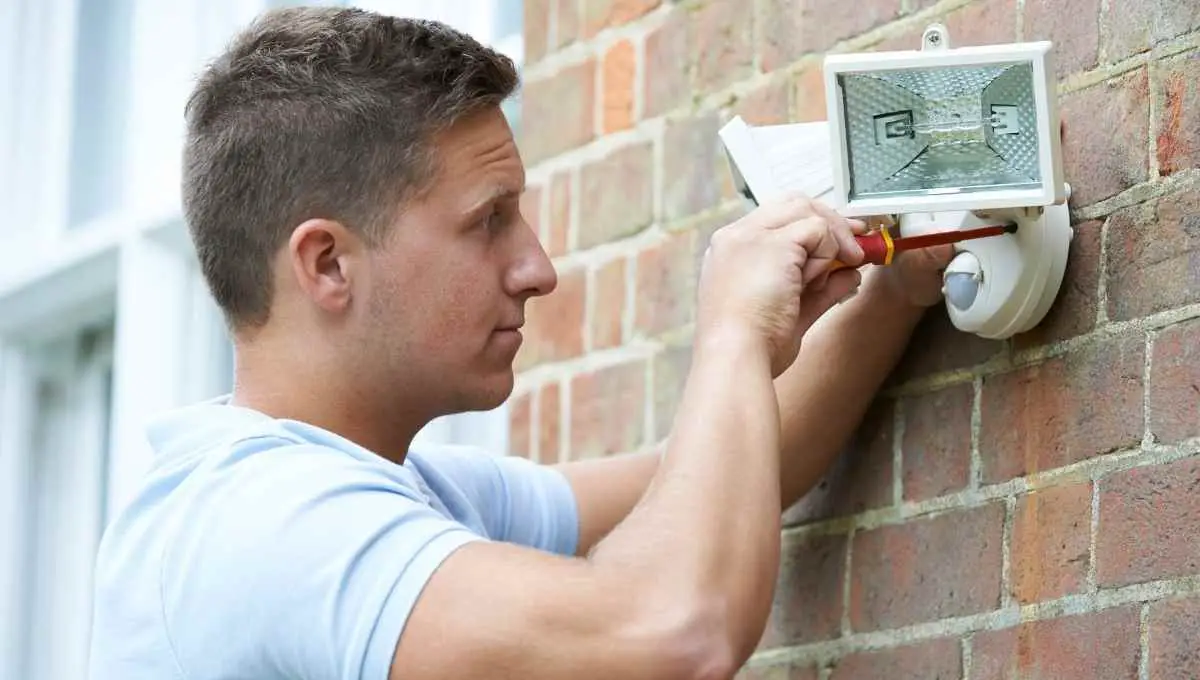
Whether you’re looking into floodlights for safety reasons or simply as a tool to light up your driveway, you might have some questions. The first question being, do floodlights need planning permission?
You don’t need planning permissions to install a floodlight on your property. However, there are other laws that you should pay attention to, such as light pollution and nuisance laws. Every state has different regulations, so it’s always best to double-check.
You might not be exactly sure what light pollution or nuisance is, so we have detailed the basics in this article. We also look at the advantages of LED floodlights over other bulbs and why floodlights are a good option.
This post contains affiliate links. This means Household Blogger may earn a commission should you make a purchase using any of our links. Please refer to our full affiliate disclosure policy for full details.
Here’s a Quick Pro Tip!
Not needing planning permissions can feel like a weight off your shoulders, but now you actually have to decide which floodlight to purchase. We have compiled the best LED floodlights on the market.
The best LED floodlights from Amazon:
1. Ring Floodlight with Camera – Ideal for security with the added benefit of a camera.
2. LE Solar 1000 lumens floodlight – Works with solar energy and uses minimal energy.
3. LEPOWER 3500 lumens floodlight – Perfect for a larger space since it has a brighter bulb.
Floodlights Laws and Regulations
In this section, we’ll dive into the different laws and regulations you need to be aware of when installing a new floodlight. It’s important to be aware of how your floodlight will affect your neighbors.
Does Installing Floodlights Require Planning Permission?
In the United States, you do not need planning permission to install a flood light on your property. However, there are some regulations that you need to follow. Several states have different regulations regarding external lighting.
One of these regulations is that outdoor lightning should be fully shielded. In short, it means that you shouldn’t be able to see the light bulb (only the light emitted) unless you’re standing directly underneath the light.
This regulation is law in some states and prevents light pollution. If your neighbors find the floodlights annoying, they can take you to court for a public nuisance and have you take the light down.
Can I Install a Floodlight Outside My House?
You can install a floodlight outside your house, although you would need to pay close attention to the outdoor lighting regulations in your state. Most states require all outdoor bulbs that are more than 150w to be partially or fully shielded.
A floodlight produces high-intensity artificial light, and they are often used in stadiums.
You can install one outside your house, but you must be mindful of how the light would affect your neighbors. They can take you to court for light nuisance if the light bothers them.
What Is the Law on Light Pollution?
There is no federal law regarding light pollution, although several states have legislations in place to combat light pollution. In most states, outdoor light fixtures must be fully or partially shielded.
You would need to double-check the specific law in your state since it’s not the same country-wide.
For example, Colorado requires consideration of costs, energy conservation, glare reduction, and some other factors when installing a new outdoor lighting fixture.
What Is the Difference Between Floodlights and Streetlights?
The main difference between a floodlight and a streetlight is the light beam. Streetlights give off a narrow beam, which only illuminates a specific area. Floodlights illuminate a large area up to 120 degrees.
Streetlights are only used on the side of a road to illuminate a small section of the road.
Floodlights are used in various industries and locations (stadiums, ports, construction sites, etc.) to illuminate a broad area.
You might also enjoy our post on If Bathroom Lights Have to be GFCI Protected
What Is the Difference Between Floodlights and Spotlights?
Spotlights have a narrow beam angle, usually no more than 45 degrees. In contrast, floodlights have a wide beam angle, between 90 and 120 degrees. Both are high-intensity beams and artificial light sources.
Spotlights are mostly used to illuminate a specific object or area, like a tree in the distance or something similar.
Floodlights are mostly used to illuminate a wider area, like a car park or construction site.
Floodlight Installation
After checking the regulations in your state and deciding which floodlight to purchase, the next step is installation.
This section will answer some of the key questions that you have regarding the installation of new floodlights.
Where Can You Use a Flood Light?
Floodlights are usually used in outdoor areas that need intense lighting, like a sports stadium or security lighting. Many also use landscaping flood lighting, especially tree lighting, to create a silhouette at night.
People use LED floodlights in their homes for security since LED lights consume very little energy when compared to traditional light bulbs.
Many people use motion-activated LED floodlights as a security measure on their private properties.
How High Should Floodlights Be?
The height of the floodlight should be half the distance of the area that needs to be illuminated. So if the floodlight needs to illuminate 60 feet of land, it should be mounted 30 feet in the air.
If you want to illuminate 20 square feet of your yard, you would need to mount the light 10 feet in the air.
Most states also require that the lightbulb of a flood light should be shielded to prevent the light from glaring into neighboring houses.
How Do I Add Floodlights to My House?
The planning for installing a floodlight is almost as important as the actual installation. Whether you are replacing an old light fixture or installing a new one, you would need to plan where and what you will be illuminating.
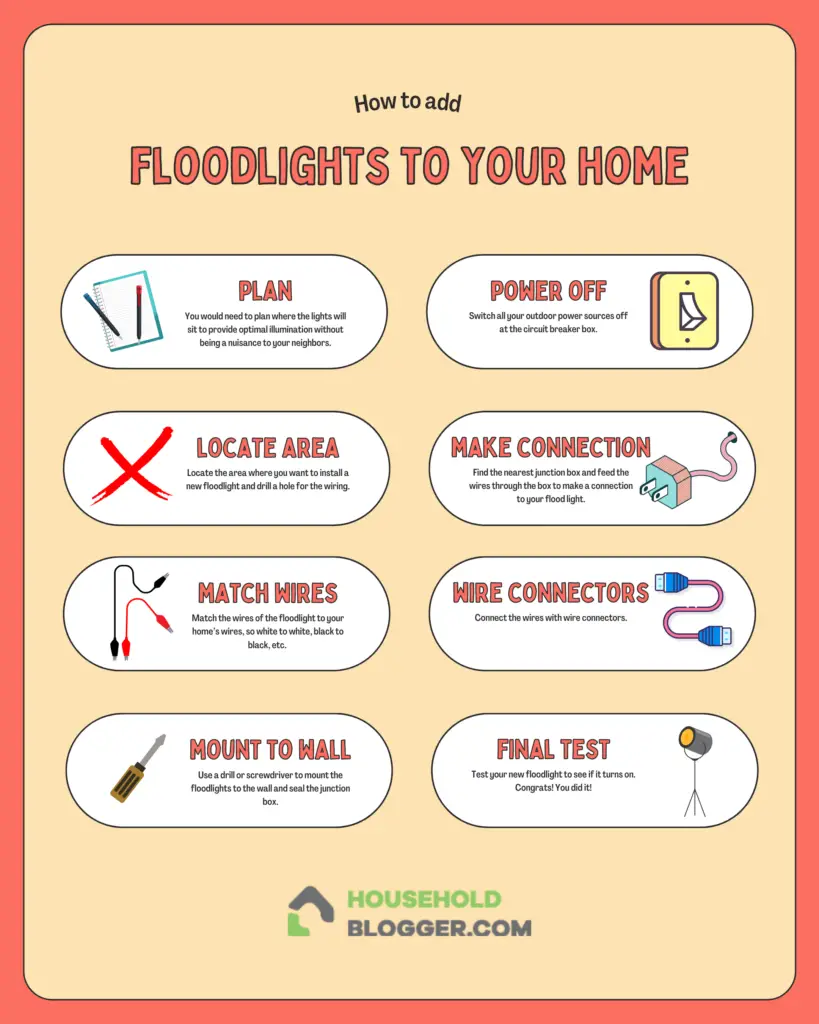
How to add floodlights to your house:
- You would need to plan where the lights will sit to provide optimal illumination without being a nuisance to your neighbors.
- Switch all your outdoor power sources off at the circuit breaker box.
- Locate the area where you want to install a new floodlight and drill a hole for the wiring.
- Find the nearest junction box and feed the wires through the box to make a connection to your flood light.
- Match the wires of the floodlight to your home’s wires, so white to white, black to black, etc.
- Connect the wires with wire connectors.
- Use a drill or screwdriver to mount the floodlights to the wall and seal the junction box.
- Test your new floodlight to see if it turns on.
Usually, floodlights will come with an installation instruction manual which you should reference.
Do You Need a Junction Box for Floodlights?
It is recommended to connect the wires of your floodlight to the house’s main wires through a junction box. This is a box that houses and protects connections from environmental factors.
Floodlights need to connect to the main line of your house. Thus, it’s always better to connect them through a junction box.
This prevents any accidental damage and can protect small fingers from possible harm.
Are LED Floodlights Any Good?
LED floodlights are one of the best outdoor lighting solutions available. It’s more affordable than traditional floodlights and has a very long life, more than 50,000 hours of light.
LED floodlights are also quite energy efficient since they only use about 70% of the energy that traditional floodlights use.
These lights are extremely user-friendly and easy to install, making them the perfect option for most homeowners.
You might also enjoy our post on If a Vacuum Cleaner can Electrocute You
Costs of Using a Floodlight
Floodlights are great for security around your house, but running the lights costs money. Let’s look at what you can expect on your electricity bill and which bulbs might be the best option.
How Much Does It Cost to Run a Floodlight?
The exact amount differs on the wattage of the bulb and the electricity rates in your state. A residential floodlight requires a much lower wattage bulb than a sports stadium, so on average, you can expect to pay less than $30 per month to run a floodlight.
To run an average LED floodlight bulb (100W) for 12 hours a day will cost you $4 per month and $44 per year.
You can use this calculator to determine what your monthly cost will be to run an LED floodlight.
How Much Does a Floodlight Cost?
Depending on various factors, floodlight prices can range from $10 to $2000. Usually, you can find a good quality motion-activated floodlight for a few hundred dollars. These lights are perfect for residential use.
The Ring motion-activated floodlight with a mounted camera is one of the best LED floodlight sellers for $200.
Another option is the LE solar motion-activated floodlight, which is somewhat cheaper at $50.
How Bright Should Outdoor Floodlights Be?
Residential floodlights should be between 700 and 1500 lumens as this is typically bright enough to lighten a certain area without being a nuisance to neighbors. Stadium floodlights need to be much brighter at about 100 000 lumens.
The brighter you want the area to be, the more lumens the floodlight should be.
LED floodlights for residential use have lower lumens since you don’t need your yard to be as bright as a football stadium.
What Is the Brightest Flood Light You Can Buy?
Purchasing a light brighter than 1500 lumens on residential properties is unnecessary. One of the brightest flood lights is the Amico LED adjustable floodlight lights up to 3500 lumens.
The Amico LED floodlight can easily light up the driveway in front of your house or a good portion of your backyard.
For commercial use, you can purchase floodlights up to 300,000 lumens.
Security and Safety
The most common reason for installing floodlights is safety concerns.
Motion-activated floodlight deters anyone from looking for trouble under the darkness of the night, especially if you have cars or anything valuable in your driveway.
Are Flood Lights Good for Security?
LED floodlights can be synchronized with other security functions, such as a motion-activated trigger. This discourages any trouble seekers from coming too close to the property.
LED floodlights are also much cheaper to run throughout the night than traditional ones. They use only 70% of the energy and are designed to illuminate for over 10 000 hours. In contrast, incandescent lights only illuminate for 1000 hours and use much more energy.
How Much Area Does a Flood Light Cover?
The area that a floodlight covers depends on the lumens of the LED light bulb. A 100W LED floodlight has 13,000 lumens and would be sufficient to illuminate an average size backyard.
For a smaller area like a driveway, a 15W LED floodlight would be satisfactory and shine at 1500 lumens.
Large commercial spaces need much brighter floodlights, and parking lots would need a 300W LED floodlight that shines at 400,000 lumens.
Are Halogen Floodlights Safe?
The halogen bulb uses 90% of its power to give off heat. The bulb gets extremely hot and can potentially burn anyone who touches it, so these lights are not considered safe, especially around young children.
This extreme heat that the halogen bulbs emit could also be a potential fire hazard if the bulb is near combustible materials, like a curtain.
LED bulbs consume an average of 10W per hour, while halogen bulbs consume 100W per hour.
You might also enjoy our post on If You Can Put a Refrigerator on Carpet
Do Floodlights Get Hot?
It depends on the bulb used to power the floodlight. Halogen floodlights can get very hot and be a potential fire risk, while LED floodlights give off very little heat. Incandescent bulbs also get relatively hot.
All in all, LED floodlights are the superior choice due to their extremely long lifespan.
LED lights are also the cheapest lightbulb to run since they are extremely energy efficient and produce the least heat.
Related Questions
How Do I Block My Neighbor’s Floodlight?
It could be quite annoying if your neighbor’s floodlight is shining into your windows. The best option is to head over to their house and casually discuss the floodlight shining into your house with them (do not get aggressive).
In most cases, the neighbor is unaware of the nuisance and will immediately rectify it.
Although if your neighbor does not modify the floodlight, you can sue your neighbor for nuisance and have the court insist on alternations.
Do Security Lights Need Planning Permission?
Security lights do not need planning permission, although you are responsible for ensuring that your lights meet all state regulations. Light pollution and nuisance laws are strictly enforced in most states.
You must shield your light to keep it from glaring into neighboring windows.
Luckily, most security lights have a shield or partial cover designed into the fitting, making it easier for you to abide by regulations.
Can I Replace Flood Lights With LED?
You can replace your old floodlights with LED floodlights, as most people do. LED bulbs have multiple advantages over normal incandescent bulbs or even halogen bulbs, so there are no two ways about it.
LED bulbs consume less energy and last almost five times as long, making them low-maintenance. They are a lot brighter than incandescent bulbs.
A 10w LED bulb, for example, is almost five times as bright as a 10W incandescent bulb.
Final Thoughts
You do not need planning permissions to install a floodlight on your private or commercial property. You would, however, need to consult the state regulations regarding light pollution and nuisances.






